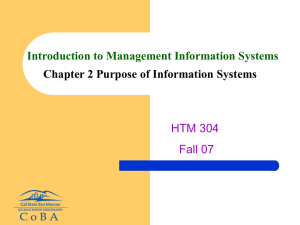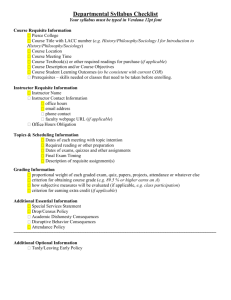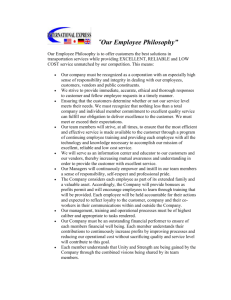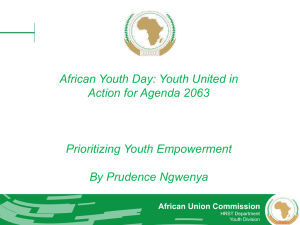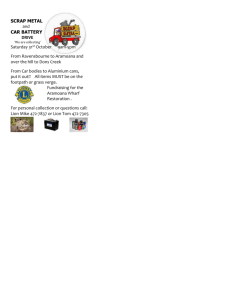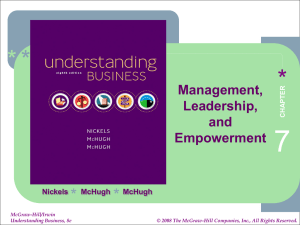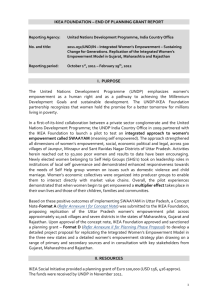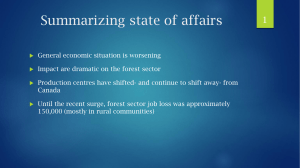RX For Success - parm radiology
advertisement
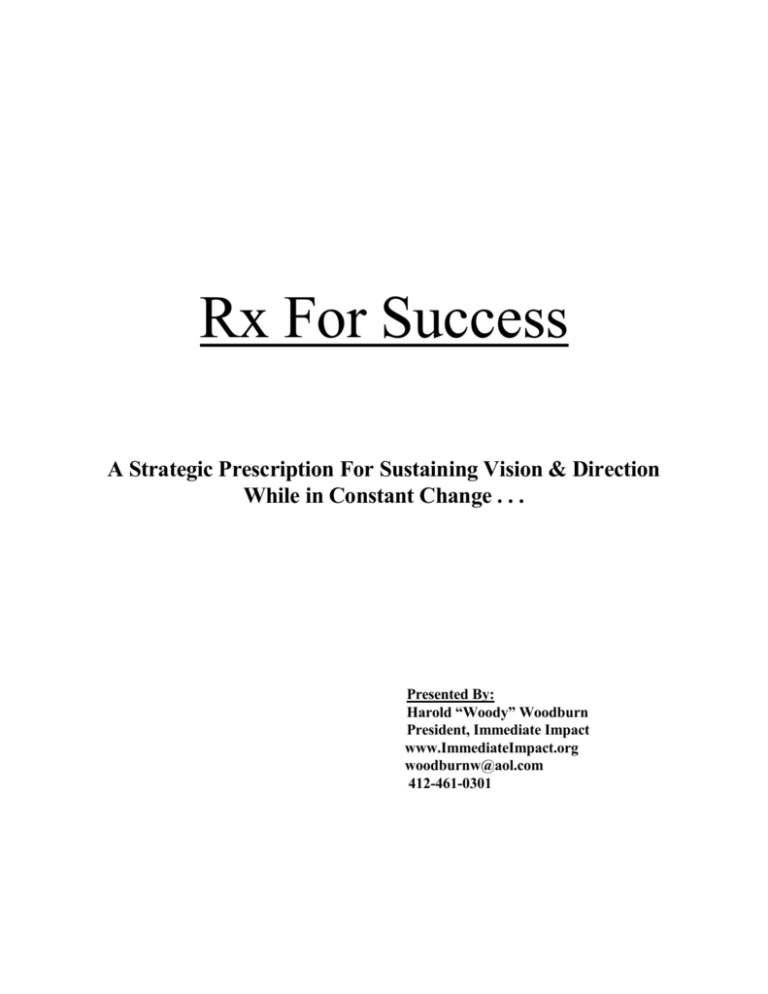
Rx For Success A Strategic Prescription For Sustaining Vision & Direction While in Constant Change . . . Presented By: Harold “Woody” Woodburn President, Immediate Impact www.ImmediateImpact.org woodburnw@aol.com 412-461-0301 PURPOSE To provide you with a `working', daily philosophy that will enable you to perform more effectively, and achieve your personal goals via decision making based on a strategic, customer-oriented direction. LEARNING OBJECTIVES Using the information provided in this workshop, you will be able to: 1. Briefly explain the (4) characteristics that individuals and organizations need to be successful in the new millennium, and use these strategies to influence the actions of others, including those interviewing you for a designated position. 2. Describe how the terms "Apostle" and "Terrorist" apply to customer driven organizations, and its application to “your” daily performance. 3. Explain the "Law of Requisite Variety" by applying it to processes in your organization and department. 4. Explain how "Management Myopia" relates to "Quality of Life" and the 3 legged stool, as well as describe how it can be used as a personal mission statement on and off the job to enhance customer loyalty and your employability. 5. Define the terms "efficient" and "effective" via a real world example. 6. Describe how "Empowerment" and "Situational Leadership" are related, and explain whether or not employees are empowered to do their jobs effectively via these two concepts. 7. Using the format and methodology provided, create customer service models at a designated level – organizational, departmental, or individual. 2. TOPIC OUTLINE • CUSTOMER DRIVEN Raving Customers = Apostles & Terrorists Guidelines & Philosophy • CONTINUOUSLY IMPROVING Measurement The Law of Requisite Variety • COST EFFECTIVE The Bottom Line & Management Myopia Efficient and Effective • FAST AND FLEXIBLE Change and Competition Empowerment & Situational Leadership 3. THE FUTURE? Once upon a time you could live in three tenses--the past, the present, and the future. There was a time to consult history; there was a time to plan for what lay ahead... The present tense was spent managing the transfer of the past into the future and imagining what the future might be... Today, under the pressure of accelerating change, the past and future have been fused into a single tense: The Present. Price Pritchett - “Fast Growth” 4. THE FUTURE? • • • • Blue Cross is saying that in the future (next few years), they see a need for only about 1/3 of the specialty care physicians, and between 1/3 and 1/2 of the current patient beds in Allegheny County. It is possible that 1 or 2 hospitals in the city could close their doors or drastically reduce their operational levels. Blue Cross has over 72% of the HMO market share and is increasing in some areas. ". . .If I were a patient, I would prefer to be here more than in any other hospital in the city..." Henry Mordoh, President Shadyside Hospital Department Head Meeting December, 1994 5. •CUSTOMER DRIVEN• • Your organization is “serious” about delivering “excellent” Customer Service. TRUE or FALSE • In order to be customer driven, who do you have to please? • Who are your customers? • 2 Basic types of customers: • Service(s) “Do Not Necessarily” = • Create storyteller(s) via "Moments of Truth" (MOT) • Philosophy & Guidelines are super critical and: Service 1. Are they out there? 2. Are there standards? 3. Are they shopped? 4. Are people accountable? 6. •CONTINUOUSLY IMPROVING• • Can you continuously improve “anything” if you are not measuring it? • The importance of measurement can't be overemphasized. If you can't measure it, you can't understand it. If you can't understand it, you can't control it. If you can't control it, you can't improve it. J. Harrington "The Improvement Process" • The most successful organizations today measure all the appropriate things; if you aren't measuring customer service, it's not important. 7. LAW OF REQUISITE VARIETY ( Problem Solving via a Scientific Methodology ) WHAT’S MISSING? Since only specific problems can be solved, the only place where something positive can be done about productivity or quality is at the _____________________ ________, which is the source of the problem or where the activity takes place. This also explains why top-down planning and decision making is most effective when it is supplemented by bottom-up information.. 8. I x P = O ( Input x Process = Output); $$$ To change the output of any process, the input, the internal processes, or both must change. $$$ Extra Notes Page……..(take as many as possible….you can use these concepts tomorrow!!!) 10. •COST EFFECTIVE• PROFITS (Revenues) MUST EXCEED EXPENSES MANAGEMENT MYOPIA: WHAT BUSINESS ARE YOU IN? EFFICIENT AND EFFECTIVE: 11. •FAST AND FLEXIBLE• "FROM 1946 TO 1975 YOU COULDN'T SCREW UP AN AMERICAN COMPANY IF YOU TRIED..." (Tom Peters) • Competition and Change • Do most people like change? Why? • How can you help people to not fear change? • Empowerment (vs) Bicycle Leadership 12. Situational Leadership High High S & Low D High D & High S Support Coaching Delegation Direction Supportive Behavior Low D & Low S LOW Directive Behavior 13. High D & Low S QUALITY... ... begins at the top and must be carried out by a well formulated plan. ... means all efforts must be directed toward the most important source in your quality efforts: The Customer. ... is assured via Employee Training, Empowerment and Reward. ... uses tools and techniques such as SPC methods combined with a breakthrough `mindset' to measure and assure success. ... is a race without a finish line, requiring on-going commitment. COMMITMENT... Every morning in Africa, a gazelle wakes up. It knows it must outrun the fastest lion or it will be killed. Every morning in Africa, a lion wakes up. It knows it must run faster than the slowest gazelle or it will starve. It doesn't matter whether you're a lion or a gazelle when the sun comes up, you'd better be running. Author Unknown 14.
